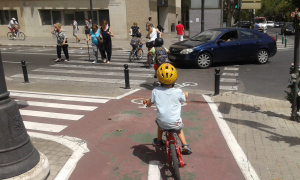IFIC participates in the development of a system to accurately measure urban traffic emissions in cities
A team from the ITACA Institute at the Universitat Politècnica de València (UPV), in collaboration with the Institute of Corpuscular Physics (IFIC), a joint centre of the Spanish National Research Council (CSIC) and the University of Valencia (UV), has developed a methodology that allows for the calculation of pollutant gas emissions generated by traffic on each street in the city of València, hour by hour. The system combines data gathered from the city’s existing traffic sensors with internationally recognised standard emission models.
Thanks to this work, it has been possible to identify the areas most affected by traffic-related pollution. The most polluted zones include the northern (Av. de Catalunya, Av. Hermanos Machado) and western (Av. del Cid, Tres Forques entrance) entrances to the city. Other roads with high traffic density, such as Pérez Galdós and Giorgeta avenues, also stand out for their high emission levels.
According to the study, in 2021 road traffic in València generated over 600,000 tonnes of greenhouse gases, in addition to pollutants such as nitrogen oxides, carbon monoxide, volatile organic compounds, and particulate matter.
The impact of bike lanes
The method developed by the ITACA Institute and IFIC (CSIC-UV) also allows the evaluation of the impact of implementing new sustainable urban mobility measures. As an example, the ITACA team analysed the effect of converting a traffic lane into a bike lane on Avenida Reino de València. Following this change, emissions in that section were reduced by more than 45% during peak hours.
“The model enables the direct estimation of the impact of specific measures with a level of detail that was previously unattainable. This allows us to simulate which actions would have the greatest impact on reducing emissions and thus invest available resources in the most efficient way,” says Edgar Lorenzo Sáez, researcher at the ITACA Institute.
Emission reduction between 2016 and 2021
The study by the UPV and IFIC team also confirms a progressive reduction in emissions in the city of València between 2016 and 2021. During this period, pollutants such as carbon monoxide and volatile organic compounds fell by more than 30%. According to the study, this decline is linked to a reduced presence of diesel vehicles and a still limited but increasing adoption of hybrid and electric vehicles.
A more precise system
Until now, air quality control in València relied on data from nine fixed monitoring stations across the city. “These stations do not provide a complete picture of the city. Our system allows for coverage of the entire city, including streets and neighbourhoods without direct monitoring stations,” says Jose Vicente Oliver, professor at the UPV and researcher at the ITACA Institute.
“This detailed analytical capability is particularly useful for planning low-emission zones, prioritising interventions in sensitive areas (such as schools or healthcare centres), and assessing whether certain measures shift pollution to other areas or time slots. This ensures that one area is not unfairly burdened by emissions relocated from another part of the city,” adds Javier Urchueguía, professor at the UPV and researcher at the ITACA Institute.
IFIC contributed to the processing of data collected by more than 3,500 electromagnetic loops installed across the city to measure the traffic intensity of cars, bicycles, and scooters. “Current data analysis techniques were key to cleaning, validating, and structuring the massive volume of information generated by the traffic management system,” explains Miguel García Folgado, CSIC researcher at the Institute of Corpuscular Physics. “This made it possible to study the impact of traffic on urban pollution with unprecedented spatial and temporal resolution, accurately identifying critical emission hotspots.”
To carry out the study, the UPV and IFIC team had the collaboration of the València City Council, which provided access to traffic management data, and the support of the Valencian Innovation Agency (AVI) through the AVI AirLuisa project.
References:
Edgar Lorenzo-Sáez, Javier F. Urchueguía, Miguel García Folgado, Jose-Vicente Oliver-Villanueva, Methodology development for high-resolution monitoring of emissions in urban road traffic systems, Atmospheric Pollution Research, Volume 16, Issue 9, 2025, DOI: https://doi.org/10.1016/j.apr.2025.102600




















